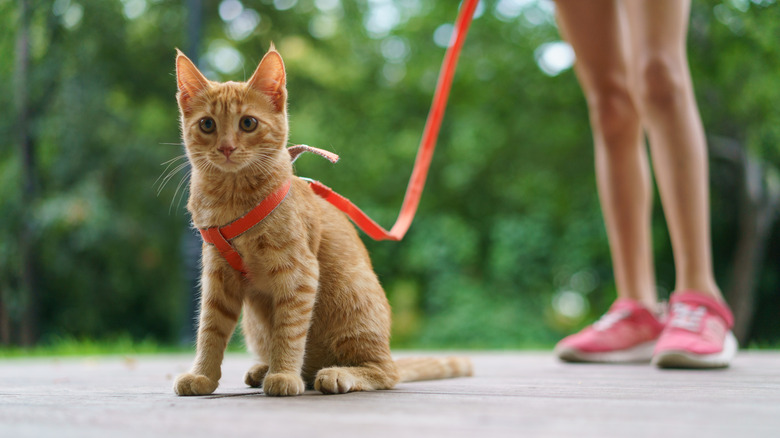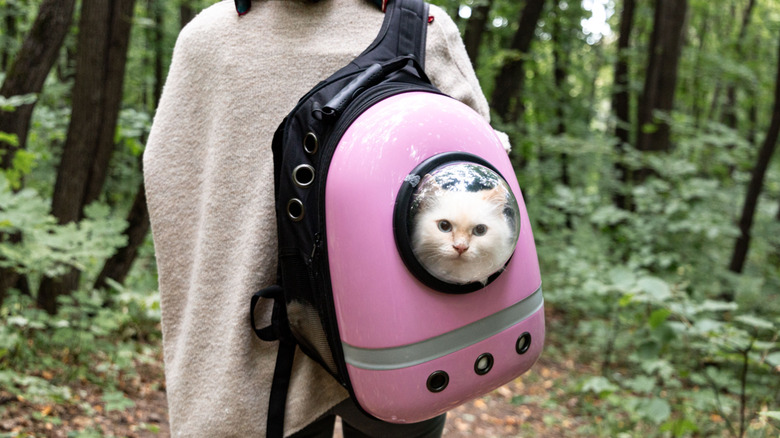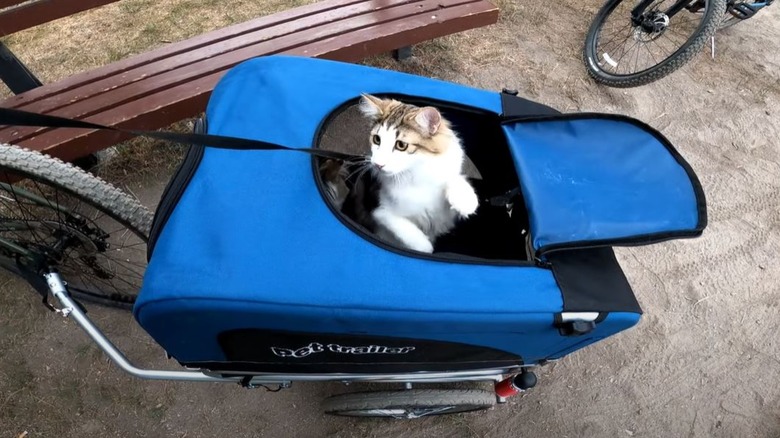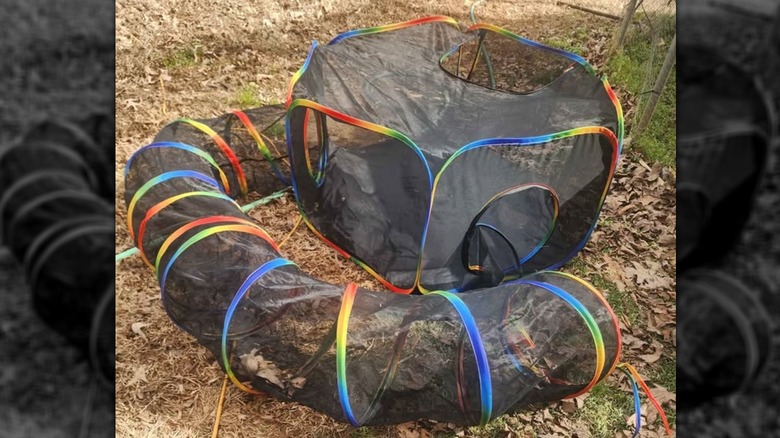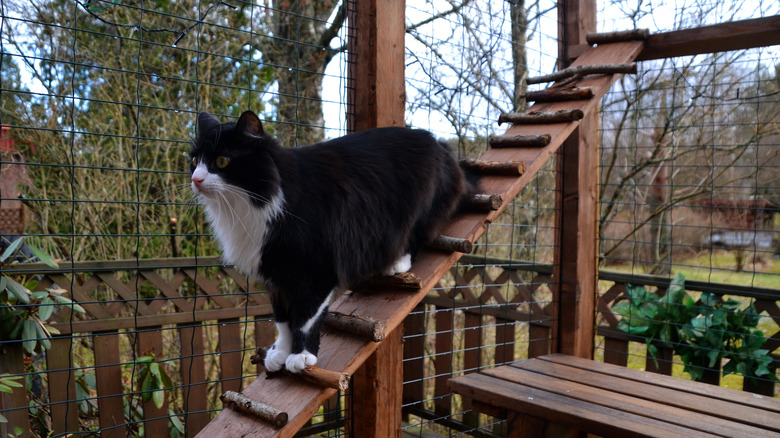Ways To Let Your Indoor Cat Play Safely Outdoors
We may receive a commission on purchases made from links.
Domesticated or not, cats are predators, and with their natural hunting instincts comes the desire to venture outside, even if they've lived their entire lives indoors. Perhaps you have a cat that spends hours staring out of a window, chirping and pawing at the glass each time it sees a squirrel or bird. The great outdoors provides physical and mental benefits for cats, but it can also be risky. The good news is that if your indoor feline friend longs for adventure beyond your home, it can play outdoors safely in several ways. You can take it for a walk on a leash, in a backpack, or in a stroller; pull it in a bike trailer; or purchase an enclosure.
Some cats have no interest in exploring more than 10 yards from home, especially senior cats. They just want to walk around the yard for a bit before lying down to enjoy the fresh air and sunshine. Younger cats, on the other hand, may want to climb trees or even hunt. Nobody knows your kitty better than you do, so the outdoor option you choose should depend on its age, personality, and interests, as well as your own interests and preferences.
Does your cat behave while in its carrier? This experience would be similar to being in a backpack or stroller. Do you like taking walks or riding your bike? Do you prefer paved paths or trekking on dirt trails through the woods? Regardless of your answer, there's a way for every indoor cat to enjoy some time outside safely.
Take your cat on leashed walks
It's not every feline's ball of yarn, but some cats can be leash trained and enjoy walks around the neighborhood or even through a wooded walking trail. However, there are some crucial steps you should never skip when leash training a cat, and you'll have a better chance of success if your furry friend is under a year old. The full training process, which may also include harness acclimation, could take weeks or longer.
Once your cat is leash trained, you can either allow it to walk around your backyard to start. For some cats, backyard time on a leash is sufficient to slake their curiosity and stimulate their senses. You can enhance the yard experience for your cat by adding toys to encourage play and its prey drive. Just be sure to use a long yard leash (about 30 feet) like the Cherpet Reflective Cat Leash.
If your cat seems more interested in what's on the other side of your yard, you might be able to walk it down the nearest sidewalk or other walking path. For your pet's protection, aim for sidewalk adventures in areas that don't have a lot of traffic or dogs, as these stimuli could frighten your cat.
Get your pet a backpack or stroller
While outdoors, some cats prefer the comfort and safety of an enclosed space, such as a pet stroller like the MoNiBloom 3 Wheels Pet Stroller or backpack like the Cawypety Cat Backpack Carrier, over being out in the open. Or, sometimes the owners are the ones who prefer this alternative over a leash, as it could reduce the chances of escape. Choose between a hard-plastic or mesh-windowed style for the backpack and a wide range of options for the stroller, including jogger, three-wheeled, four-wheeled, zip, and no-zip styles.
Unsure how to stroller train your cat? The process is similar to that of carrier training and could take days or weeks, depending on your pet's response. It also compares to leash training in that it involves using a harness. If the stroller comes with an interior tether/leash, attach your cat's harness to it, and secure the stroller cover before starting your walk. The backpack method will also involve an acclimation period. With this alternative, you can be hands-free as you "wear" your cat on your chest or back during a peaceful hike through the woods or your nearest park.
Although a backpack or stroller won't allow your furry friend to run around or play the way a leash would, it still offers plenty of enjoyment opportunities. For example, your cat can still soak in the sights, smells, and sounds of the great outdoors, even if it can't touch anything. You can also toss a toy inside the stroller or backpack for some added fun.
Invest in a pet bike trailer for your cat
You've probably seen someone riding a bike with a child in a trailer behind them, but children aren't the only ones who can enjoy these adventures; cats can tag along on their humans' bike rides, too. You can find bike trailers designed specifically for pets in various sizes, with some doubling as strollers. This can be a great selection if you're a bicycling enthusiast who wants to cover more ground with your pet than you would on foot, allowing for more sightseeing.
Just as with a traditional stroller, your cat will likely jump into the trailer as soon as you assemble it. Plan to leave the trailer out in the open at least a few days before your bike ride to allow your cat to get comfortable with — and in — it. Harness training may also be required if the trailer comes with a tether that you plan to use.
Since not all cats respond the same way to being in a moving vehicle, it's best to start with short bike rides around the neighborhood. Gauge your cat's reaction to determine if you can extend the length of the next ride or if you need to return to the training phase. Once your cat reaches a level of comfort with being in the bike trailer for more than a few minutes, you can expand your location options.
Set up a mesh cat enclosure
A mesh cat enclosure gives your cat the freedom to play outdoors between mesh tunnels and walls. These enclosures offer convenient portability so you can set them up anywhere in your yard. You can also fold or collapse them and place them in a storage bag when not in use. You can have a simple infinity tunnel or a full playground with a cube or tent and connecting tunnels, like the LUCKITTY Outdoor Rainbow Cat Enclosures Playground.
Want your kitty to have the freedom to cover more ground while contained in the enclosure? Consider purchasing a mesh cube like the Pawtenda Cat Tent Accessory and see if it learns how to roll it; Memezar posted a video on Facebook of a cat named Daisy that learned to do just that. Just remember to keep an eye on the cube to ensure it doesn't get punctured or damaged on something sharp.
Regardless of which type of mesh enclosure you purchase, you should always check all the sides for rips or tears. Check the zippers, too. Make sure they're closed all the way before placing your cat in the enclosure, and never leave your cat in a mesh enclosure outdoors when you're not home.
A catio could be purrfect for your kitty
With a catio, your cat can safely watch squirrels and birds from your porch, deck, patio, or just the side of your house without wandering off. Catios are screened-in enclosures that come in a range of sizes, and some come with wheels, allowing you to easily move it around. Choose between metal or wooden construction in a pre-designed kit, or take the DIY approach and build your own from scratch. Many kits come with shelves, compartments, or both, giving your cat places to perch, nap, and hide.
One advantage that a catio offers that none of the other methods above offer is that it allows your cat to go outside without opening a door if you build it as an attached catio; you can build it flush against the side of your home in front of a window or sliding door with a small pet entrance. However, this would eliminate the option to move the catio around.
A catio, or any type of enclosure, doesn't require harness training like other methods do, so it might be a good option if your cat hates wearing a harness or being confined in small spaces. The main downside is that some of these enclosures can be expensive, with some costing hundreds of dollars or more. But, on the other hand, when you consider your cat's enjoyment, you'll likely find it the catio worth the price.

